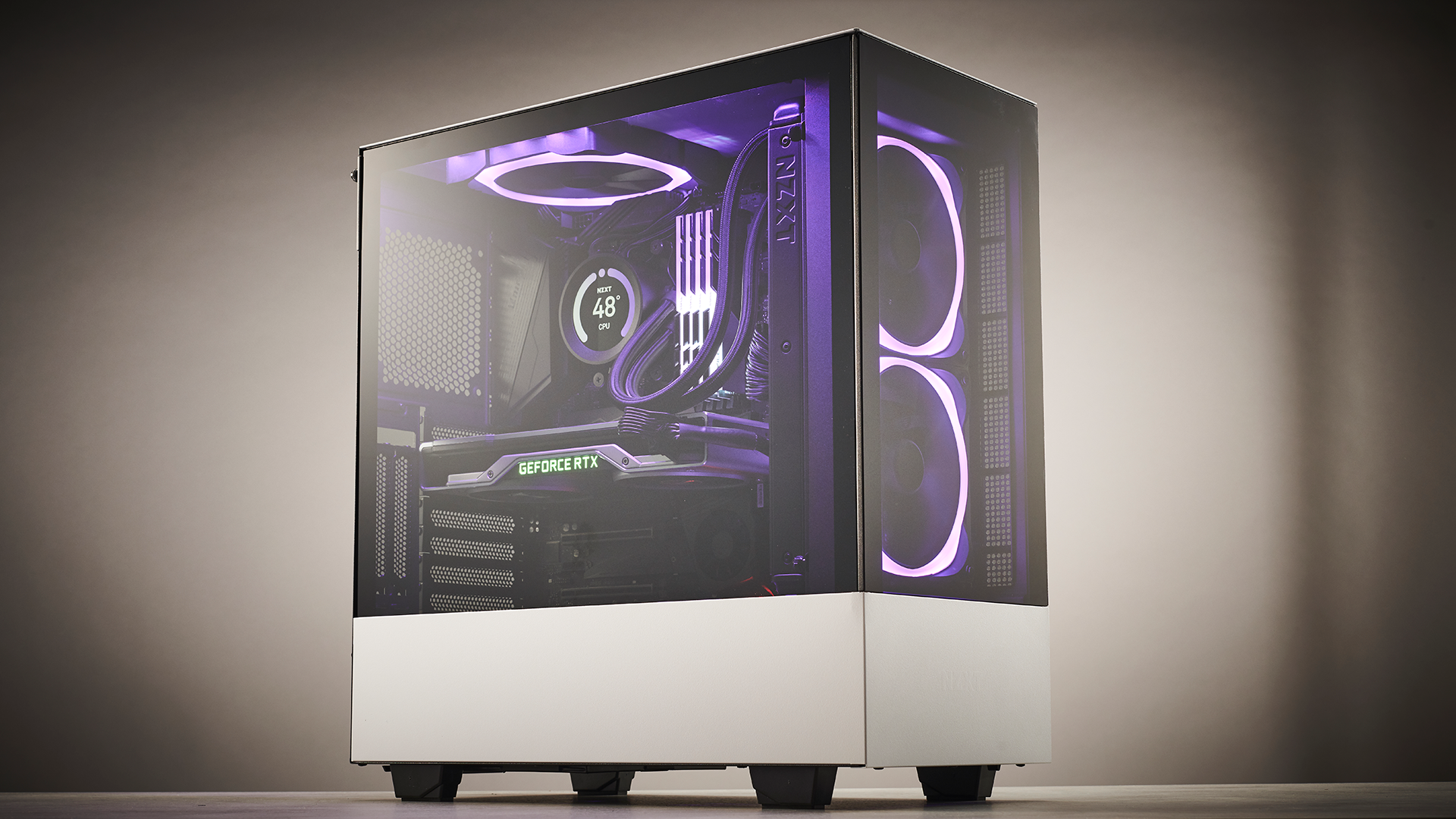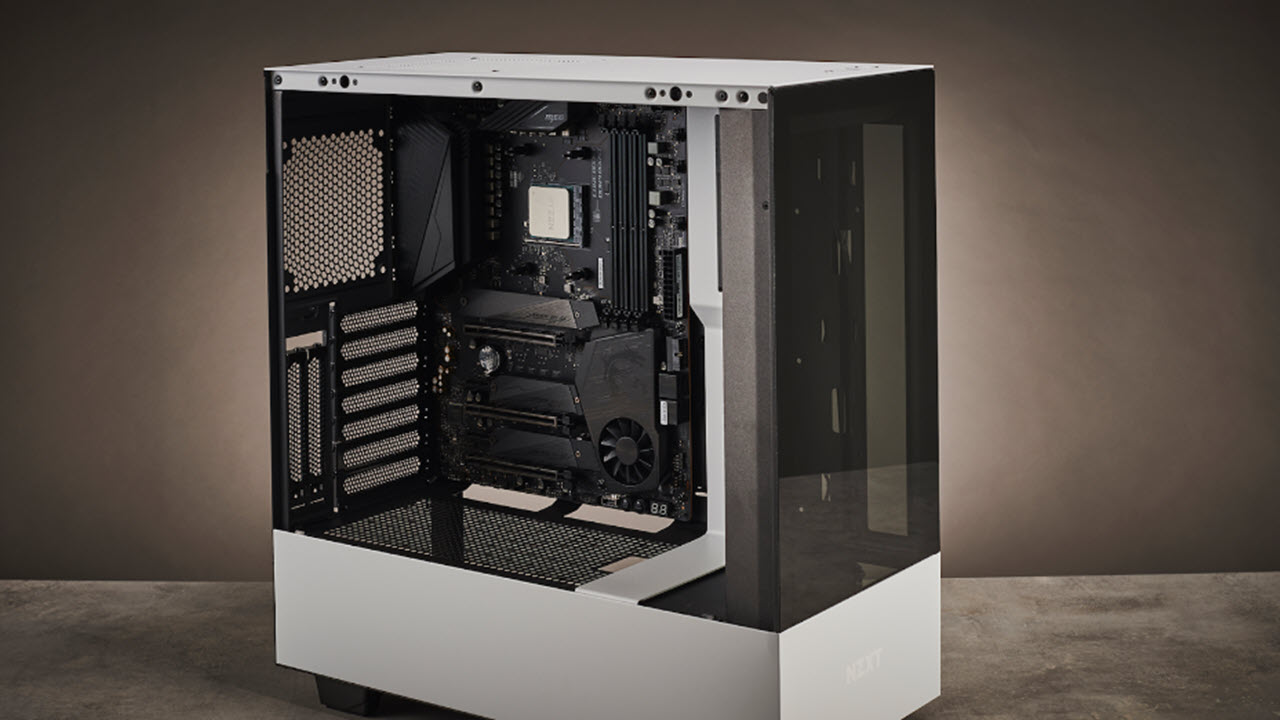Building a $2,000 1440p Gaming PC
Combining some of NZXT’s finest RGB to create a 60fps 1440p Gaming PC
With this system build, we wanted a PC that could comfortably game at 1440p (60 fps or higher), without breaking our $2,000 budget. For us, the $1500-2000 mark easily constitutes a mid-to-high end 1440p system, and aiming for the top of that bracket allows us to stretch for a few luxury components that should really make the machine pop on your desktop.
To achieve this, we’ve picked up a selection of classy RGB components and high-end hardware, including the NZXT Kraken Z63 cooler with in-built display, the H510 Elite tempered glass chassis, some brand new G.Skill Trident Z Neo memory, an AMD Ryzen 5 3600X processor, and Nvidia’s GeForce RTX 2070 Super Founders Edition graphics card.
Choosing the Components
We knew from the get-go that this was going to be a pricey build. RGB lighting may be popular. but it comes with a premium, and it’s often attached to only the most high-end of components. To that end we decided to opt for some lower specced parts to reduce the overall cost here and there, including the power supply and storage.
CPU: AMD Ryzen 5 3600X
With six cores, 12 threads and a 4.4 GHz clock speed AMD’s Ryzen 5 3600X is an ideal part for 1440p gaming. Not only can it handle all of your framerate needs, but it’s also a well-equipped processor capable of taking on streaming and video rendering tasks too.
Graphics Card: Nvidia GeForce RTX 2070 Super
We set out to use a standard RTX 2070 for this build, but almost all of them are now more expensive than the Super. Given that the Super also includes an additional 256 CUDA cores and a beefier core clock than the original 2070, it made sense to opt for this card instead.
At 1440p, the 2070 Super outperforms the 2070 by a good 10%, and in our full review we found it comfortably hit around 100fps in Far Cry 5, Battlefield V, Forza Horizon 4 and more.
Motherboard: MSI MEG X570 UNIFY
This is one of the few areas we could’ve saved money. There are a lot of affordable, stylish, X570 motherboards out there. But we went with MSI’s MEG X570 Unify, as it provides plenty of connectivity and looks very clean with a complete brushed-aluminum and black finish throughout.
Get Tom's Hardware's best news and in-depth reviews, straight to your inbox.
RAM: 32GB (4x8GB) G.Skill trident Z Neo @ 3600
AMD Ryzen performance actively scales with memory frequency thanks to its memory controller being directly integrated with the Infinity Fabric interconnect. With Zen 2, that memory controller decouples from the fabric at 3,733 MHz, making 3,600 MHz the sweet spot for price and performance.
For that reason we’ve opted for a set of G.Skill Trident Z Neo RAM and 32GB at that speed. You could live with 16GB just for gaming, but memory prices have been creeping back up, so future upgrades might be pricier. And this way we ensure we’ve got more than enough capacity for any and all applications we throw this system’s way.
Power Supply: 750W NZXT C750 Modular 80+ Gold
We’ve decided to save some cash on our PSU choice by using NZXT’s latest C750M modular power supply. We’re expecting our system to draw around 374W at max from the wall when running at stock, so having just under twice the capacity at our fingertips gives us plenty of headroom. Couple that with an 80+ Gold efficiency rating and a 10 year warranty, and it’s a solid pick.
Storage: 500GB Corsair Force MP600 M.2 PCIe 4.0 SSD, 1TB Crucial P1 M.2 PCIe 3.0 SSD
For storage we’re going to rely entirely on M.2 drives to power this build. Our main OS drive is the 500GB Corsair Force MP600. It’s a PCIe 4.0 drive, with read and write speeds rated way up at 4,950/2,500 MB/s, which should give us plenty of performance for our OS and primary programs.
For our secondary drive, we’ve gone for a 1TB Crucial P1. Aside from being very affordable, this drive actually edges out our favorite budget M.2 PCIe SSD, the 1TB Intel 600P, in sequential performance metrics too, with native read and writes of 2000/1700 MB/s.
Case: NZXT H510 Elite
For our chassis we’ve opted for the NZXT H510 Elite. This dual tempered-glass case includes two of NZXT’s 140mm AER RGB 2 fans as standard, which is ideal for our Kraken Z63. On top of that it’s also got a very clean interior, an integrated fan controller, and plenty of cable management options to make any build easy to keep tidy.
Fans: 1x NZXT 140mm AER RGB 2
As mentioned above, two of these fans were included with the case, however the top most exhaust we’ve installed ourselves. The AER RGB 2 fans are impressively colorful and particularly good at diffusing their light. Sadly, the 140mm variants don’t feature the best static pressure performance.
Cooler: NZXT Kraken Z63 280mm AIO
This 280mm AIO features an integrated 2.36” LCD screen capable of displaying 24-bit color. On top of that, using NZXT’s CAM software you can configure it to show off a multitude of different system stat screens, or even gifs and videos.
| Header Cell - Column 0 | Product | Cost |
|---|---|---|
| Processor | AMD Ryzen 5 3600X | $179.99 |
| Graphics Card | Nvidia GeForce RTX 2070 Super | $499.99 |
| Motherboard | MSI MEG X570 UNIFY | $299.99 |
| Memory | 32GB (4x8GB) G.Skill trident Z Neo @ 3600 | $219.99 |
| Power Supply | NZXT C750 Modular 750W 80+ Gold | $119.99 |
| Storage 1 | Corsair Force MP600 M.2 PCIe 4.0 SSD 500GB | $139.99 |
| Storage 2 | Crucial P1 M.2 PCIe 3.0 SSD 1TB | $114.99 |
| PC Case | NZXT H510 Elite | $149.99 |
| Fans | 1x NZXT 140mm AER RGB 2 | $30.99 |
| PC Cooler | NZXT Kraken Z63 280mm AIO | $234.48 |
| TOTAL | Row 10 - Cell 1 | $1,990.39 |
MORE: Best Gaming Desktops
MORE: How To Build A PC
MORE: All PC Builds Content

As Associate Editor of Tom's Hardware's prestigous British division, Zak specializes in system building, case reviews and peripherals, and has a particular penchant for liquid-cooling. He's also a lover of all things Viking/Scandinavian (thus the poor attempt at a beard).
-
logainofhades What a horrible way to spend $2000. Making it pretty, vs performance, is simply never a good idea. Far superior streaming, and gaming performance.Reply
PCPartPicker Part List
CPU: AMD Ryzen 9 3900X 3.8 GHz 12-Core Processor ($418.95 @ Amazon)
CPU Cooler: EVGA CLC 280 113.5 CFM Liquid CPU Cooler ($109.99 @ Amazon)
Motherboard: MSI B450 TOMAHAWK MAX ATX AM4 Motherboard ($114.89 @ B&H)
Memory: G.Skill Ripjaws V 32 GB (2 x 16 GB) DDR4-3600 Memory ($159.99 @ Newegg)
Storage: Intel 660p 512 GB M.2-2280 NVME Solid State Drive ($62.99 @ Newegg)
Storage: Crucial MX500 2 TB 2.5" Solid State Drive ($229.99 @ Amazon)
Video Card: EVGA GeForce RTX 2080 SUPER 8 GB BLACK GAMING Video Card ($699.99 @ Amazon)
Case: NZXT H510 ATX Mid Tower Case ($69.98 @ Amazon)
Power Supply: SeaSonic FOCUS Plus Gold 750 W 80+ Gold Certified Fully Modular ATX Power Supply ($114.99 @ B&H)
Total: $1981.76
Prices include shipping, taxes, and discounts when available
Generated by PCPartPicker 2020-03-13 10:58 EDT-0400 -
gfg Choosing the B450 chipset for the Ryzen 3900 is not a smart choice either. Mandatory X570.Reply -
logainofhades Replygfg said:Choosing the B450 chipset for the Ryzen 3900 is not a smart choice either. Mandatory X570.
The B450 Tomahawk max VRM's can handle a 3900x. An x570 is not mandatory. Some x570's actually have worse VRM's than that board. -
AnimeMania Do you really need 32 GB of RAM? I would get 16 GB of RAM take the 70 or so dollars and get a 3 to 4 GB mechanical HardDrive to store old games.Reply -
logainofhades ReplyAnimeMania said:Do you really need 32 GB of RAM? I would get 16 GB of RAM take the 70 or so dollars and get a 3 to 4 GB mechanical HardDrive to store old games.
For a streaming rig, 32gb isn't exactly a bad idea, to give you a bit of headroom, as games start using more ram. -
gfg In my opinion, it is best to look for a balance of components and not be tied to a figure as exact as U$D 2000. You can spend +/- 200 will not change the concept of purchase.Reply
Ryzen 7 3700X,
good x570 motherboard (for future updates CPU)
RTX 2070
2x16 GB Ram
1TB PCE 3.0 SSD / optional 2TB conventional disk
dedicated CPU cooler
good power supply
and finely cabinet aesthetics. -
SirCrono Reply
I was thinking the same while reading this article. What good is the pretty case if I'm getting 50 fps in a game?logainofhades said:What a horrible way to spend $2000. Making it pretty, vs performance, is simply never a good idea. Far superior streaming, and gaming performance.
PCPartPicker Part List
CPU: AMD Ryzen 9 3900X 3.8 GHz 12-Core Processor ($418.95 @ Amazon)
CPU Cooler: EVGA CLC 280 113.5 CFM Liquid CPU Cooler ($109.99 @ Amazon)
Motherboard: MSI B450 TOMAHAWK MAX ATX AM4 Motherboard ($114.89 @ B&H)
Memory: G.Skill Ripjaws V 32 GB (2 x 16 GB) DDR4-3600 Memory ($159.99 @ Newegg)
Storage: Intel 660p 512 GB M.2-2280 NVME Solid State Drive ($62.99 @ Newegg)
Storage: Crucial MX500 2 TB 2.5" Solid State Drive ($229.99 @ Amazon)
Video Card: EVGA GeForce RTX 2080 SUPER 8 GB BLACK GAMING Video Card ($699.99 @ Amazon)
Case: NZXT H510 ATX Mid Tower Case ($69.98 @ Amazon)
Power Supply: SeaSonic FOCUS Plus Gold 750 W 80+ Gold Certified Fully Modular ATX Power Supply ($114.99 @ B&H)
Total: $1981.76
Prices include shipping, taxes, and discounts when available
Generated by PCPartPicker 2020-03-13 10:58 EDT-0400
Your build is much much better. -
Gurg TH AMD processor reviews all tell us what a wonderful deal the cheap AMD Wraith Spire CPU cooler is. Why did you then waste money on a $234 NZXT AIO (a very good AIO) rather than just using the cheap AMD enclosed cooler that limits the CPU overclocking ability and system performance? LOLReply -
sizzling This build is like buying a Ferrari at full price and then sticking a 200bhp engine in it and running cheap tyres. Might look good but performance sucks.Reply -
chill1221 GTX 1080 tiReply
https://www.ebay.com/itm/EVGA-GeForce-GTX-1080-Ti-SC-Black-Edition-GAMING-11GB-GDDR5X-Graphics-Card/124089956485?hash=item1ce4567885:g:K9oAAOSwXc1eOwp6
Just saying...

